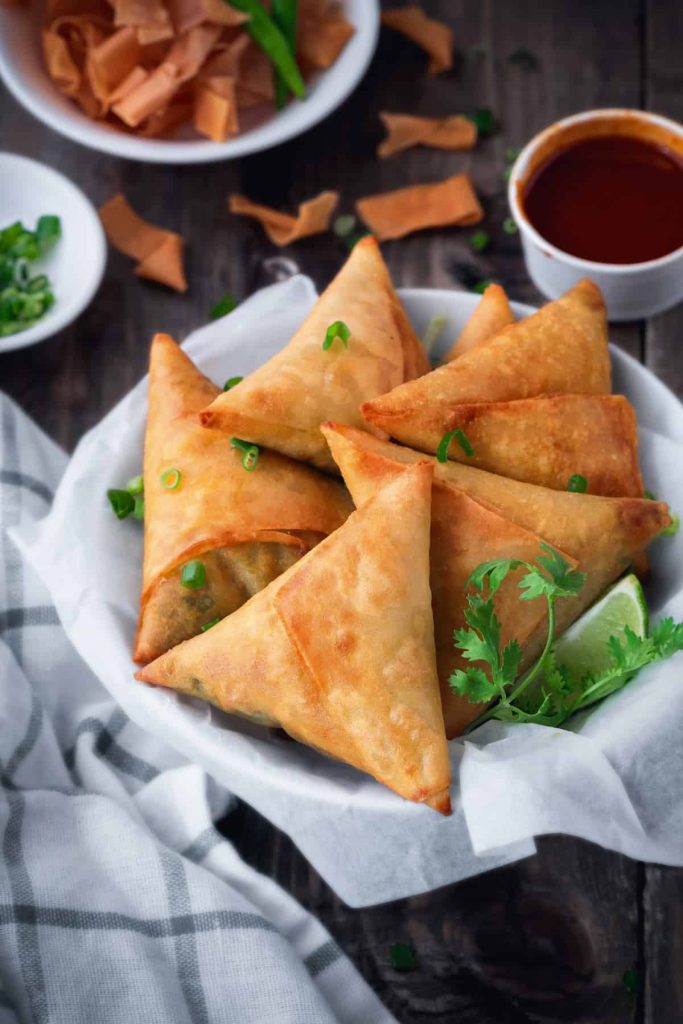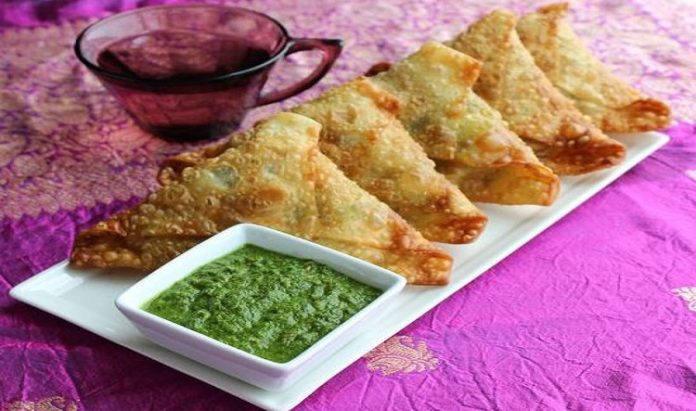By Foodie
The samosa is too Indian to have originated elsewhere, right? Wrong. The ubiquitous samosa has been more widely known around many part of the world that you may want to believe. It probably came to India from another country, which means that the dear old samosa isn’t originally Indian at all.
A samosa or singara is a fried South Asian pastry with a savoury filling, including ingredients such as spiced potatoes, onions, and peas. It may take different forms, including triangular, cone, or half-moon shapes, depending on the region. Samosas are often accompanied by chutney, and have origins in medieval times or earlier.
Samosas are a popular entrée, appetizer, or snack in the cuisines of South Asia, the Middle East, Central Asia, East Africa and their South Asian diasporas.
The word samosa derives from the Hindi word ‘samosa’ traceable to the Middle Persian word sanbosag ‘triangular pastry’, Similar pastries are called sambusak in Arabic; Medieval Arabic recipe books sometimes spell it sambusaj.
Almost anyone in the world can recognize a samosa with its uniquely chubby, tri-cornered shape. And it’s probably a rare person whose mouth wouldn’t water at the thought of eating one. The potato and pea stuffed pastry pockets are most often identified with Indian cuisine, but versions of samosa exist across many global cuisines, including in the Horn of Africa (sambusa), in the Middle East (sambousek) and in central Asia (samsa).
HISTORY
The samosa’s origins actually lie thousands of miles away in the ancient empires that rose up in the Iranian plateau at the dawn of civilization itself.
We don’t know for certain when the first cooks shaped pastry into the now-familiar triangular shape but we do know that the origins of the name are Persian – “sanbosag”.
The samosa is first mentioned in literature by the Persian historian Abul-Fazl Beyhaqi, writing in the 11th Century.
He describes a dainty delicacy, served as a snack in the great courts of the mighty Ghaznavid empire. The fine pastry was filled with minced meats, nuts and dried fruit and then fried till the pastry was crisp. But the samosa was to be transformed as it followed the epic journey made by successive waves of migrants into India.
It was brought to India along the route the Aryans had taken more than 2,000 years earlier – through Central Asia and then over the great mountains in what is now Afghanistan, before descending down into the fertile plains of the great rivers of India.
The great armies of the Mamluks, Tamerlane and the Mughals later made the same journey, helping build the great sub-continental empire we now know as India.


And, just as India was reshaped by these waves of migrants, the samosa also underwent a transformation.
Initially it metamorphosed into something much less refined.
By the time it reached what is now Tajikistan and Uzbekistan it had become what Professor Pushpesh Pant, one of the world’s experts on Indian food, describes as “a crude peasant dish”.
The courtly titbit was now a high-calorie staple, a much bigger and heartier dish – the sort of thing a shepherd would take out into the pastures with him.
It retained its distinctive shape and was still fried, but the exotic nuts and fruits were gone – the savoury pastry was now filled with coarsely chopped goat or lamb eked out with onions and flavoured simply with salt.
Over the following centuries the samosa made its way over the icy passes of the Hindu Kush and into the Indian subcontinent.
What happened along the way explains why Professor Pant regards the samosa as the ultimate “syncretic dish” – the ultimate fusion of cultures.
The British loved the samosa and spread the now uniquely Indian innovation across their vast empire – along with shampoo, bungalows, verandas and pyjamas.
And, as the Indian diaspora has spread around the globe in the last few centuries, they too took samosas with them.
Which is why what began as a tasty titbit for ancient Persian emperors is now enjoyed in virtually every country on Earth.
Different types of samosa In India
Chole Samosa
The Chole is an important constituent of every type of chaat food in India. It is prepared with a stuffing of chick peas prepared in the most aromatic spices and seasoned with coriander. The crunchy exterior of this type of samosa is in blatant contrast to the lip-smacking filling.
Keema Samosa
A keema samosa is made with spring roll wrappers and filled with spiced keema and onions. It’s then fried until golden and crispy. Of course, for a healthier alternative you can air fry these.


Chocolate Samosa
Chocolate Samosa is easy-to-make and quite scrumptious. The main ingredients are cake crumbs, chocolate chips, and dry nuts. This dessert has a crispy golden covering on the outside and creamy chocolate filling inside which would astound everyone with its luscious flavors.
Pasta Samosa
Pasta is heaven on a plate for every food lover. Pasta samosa might sound a bit peculiar, but the palate is outstanding. Making this samosa could be a bit tricky. You need to remember to make sure to make the pasta really dry and prepare a denser kind of the pasta sauce in the filling.
- Ingredients
- -500 Gram potatoes (peeled and chopped), boiled
- For the dough:-500 gram maida (refined flour)
- -1/2 cup ghee or oil
- -5 gram ajwain
- -Salt-Water
- -Oil (for deep frying)For tempering:
- -1/2 cup ghee-1 tsp cumin seeds
- -1/2 tsp turmeric powder
- -1/4 tsp red chilli powder
- -2-3 Green chillies
- -2 tsp ginger-1 Lime
- -1 tbsp coriander leaves
- -Salt-1/3 cup green peas
- -2 tsp chaat masala powder
- -1 tsp fennel seeds
- -1/2 tsp garam masala
- -2 tbsp cashew nuts, chopped
Preparation Time: 15 minutes
Cooking Time: 35 minutes
Serves: 12 pieces
How to Make Aloo Samosa:
1.Chop the green chillies, ginger and the coriander leaves.
2.Mix all the ingredients for the dough except water and rub thoroughly.
3.Sprinkle water and make a hard dough. Set aside for about 10 minutes.
4.Divide the dough into round portions as per the size of the samosas required.
5.Heat the ghee and add cumin, when crackling add ginger and saute.
6.Add the rest of the ingredients excluding the final four and sauté for five minutes.
7.Mix in the rest of the ingredients, including the potatoes and mix well.
8.Roll each portion of dough into a thin oval shape cut into 2 semi-circles.
9.Take a semi-circle. Apply water on the straight edge of the semi-circle. Hold the semi-circle in your hand, fold the straight edge, bringing together the watered edges, and seal the watered edges into a triangular pocket.
10.Stuff the potato mixture and then seal the upper edges.
11.Repeat with the rest.
12.Deep fry in oil till golden brown and serve.
Tips to Make The Perfect Samosa
Mixing the oil with flour is important– rub it for good 3 to 4 minutes, do so by rubbing between your hands until the oil is well incorporated with the flour.
Don’t overwork the dough– you only need to bring the dough together. If you overwork it, the samosa will be hard.
Dough should be stiff– soft dough will not give crispy samosa.
Let the dough rest for around 40 minutes– always remember to let the dough rest for at least 30 to 40 minutes before you start making the samosa.
Roll the dough evenly and roll it thin– try to roll the dough thin and evenly. If the dough is rolled thick, it will take a long time for the dough to get cooked. Also we all like thin crispy edges of the samosa, agree?
But don’t roll it super thin too, else the dough will tear apart when you fill it.
Do not use any flour while rolling the samosa, you can apply little oil on your rolling pin.
Fry the samosa on low heat – the most important thing- always fry the samosa on low heat (not high, not medium), that way they will turn crisp.





















